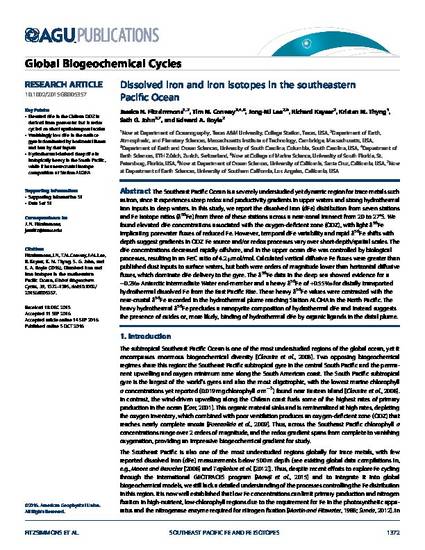
- iron isotopes,
- hydrothermal vents,
- oxygen‐deficient zone,
- Station ALOHA,
- South Pacific Ocean,
- trace metals
The Southeast Pacific Ocean is a severely understudied yet dynamic region for trace metals such as iron, since it experiences steep redox and productivity gradients in upper waters and strong hydrothermal iron inputs to deep waters. In this study, we report the dissolved iron (dFe) distribution from seven stations and Fe isotope ratios (δ56Fe) from three of these stations across a near‐zonal transect from 20 to 27°S. We found elevated dFe concentrations associated with the oxygen‐deficient zone (ODZ), with light δ56Fe implicating porewater fluxes of reduced Fe. However, temporal dFe variability and rapid δ56Fe shifts with depth suggest gradients in ODZ Fe source and/or redox processes vary over short‐depth/spatial scales. The dFe concentrations decreased rapidly offshore, and in the upper ocean dFe was controlled by biological processes, resulting in an Fe:C ratio of 4.2 µmol/mol. Calculated vertical diffusive Fe fluxes were greater than published dust inputs to surface waters, but both were orders of magnitude lower than horizontal diffusive fluxes, which dominate dFe delivery to the gyre. The δ56Fe data in the deep sea showed evidence for a −0.2‰ Antarctic Intermediate Water end‐member and a heavy δ56Fe of +0.55‰ for distally transported hydrothermal dissolved Fe from the East Pacific Rise. These heavy δ56Fe values were contrasted with the near‐crustal δ56Fe recorded in the hydrothermal plume reaching Station ALOHA in the North Pacific. The heavy hydrothermal δ56Fe precludes a nanopyrite composition of hydrothermal dFe and instead suggests the presence of oxides or, more likely, binding of hydrothermal dFe by organic ligands in the distal plume.
Global Biogeochemical Cycles, v. 30, issue 10, p. 1372-1395
This is the peer reviewed version of the following article: Fitzsimmons, J. N., T. M. Conway, J.‐M. Lee, R. Kayser, K. M. Thyng, S. G. John, and E. A. Boyle (2016), Dissolved iron and iron isotopes in the southeastern Pacific Ocean, Global Biogeochem. Cycles, 30, 1372–1395, which has been published in final form at https://doi.org/10.1002/2015GB005357. This article may be used for non-commercial purposes in accordance with Wiley Terms and Conditions for Use of Self-Archived Versions.
Available at: http://works.bepress.com/tim-conway/7/
